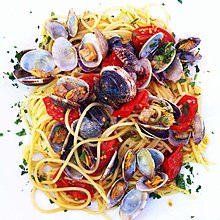spaghetti
Spaghetti [ ʃpaɡɛti ] Italian standard pronunciation [ spa'get-ti ] (as Google also spaghetti ) are made from durum wheat semolina prepared pasta or noodles (cooked) with a round cross-section, about two millimeters diameter and about 25 cm length. The spaghetti came from Italy to the German-speaking countries .
The term spaghetti was taken from the Italian (lat. Spacus “twine” → Italian spago “cord” → diminutive spaghetto → plural spaghetti “little cord ”). Particularly thick spaghetti is called spaghettoni, and particularly thin spaghettini. Capellini are even thinner than spaghettini .
In Germany, spaghetti is sometimes also offered as egg pasta with the addition of eggs . Egg noodles (Italian pasta all 'uovo ), which are also available as ribbon noodles , are similar in shape, but usually shorter than spaghetti . Vermicelli are shorter and thinner and are mostly used as a soup. According to the latest discoveries, a kind of vermicelli already existed in the 2nd millennium BC. In today's China . However, they were made from millet flour.
Spaghetti is considered a difficult dish in terms of observing table manners.
Well-known spaghetti dishes
- Spaghetti aglio e olio - with garlic and olive oil
- Spaghetti alla carbonara - with bacon , egg and cheese
- Spaghetti alla napoletana - with tomato sauce
- Spaghetti alla puttanesca - with hot and spicy tomato sauce and anchovies , peppers , olives and capers
- Spaghetti alla gricia - with fried bacon ( lardo ) and pecorino cheese
- Spaghetti alle vongole - with clams
- Spaghetti bolognese - with tomato sauce and minced meat or with ragù alla bolognese
- Spaghetti all'amatriciana - with guanciale , tomatoes , pecorino , peperoncini (chili peppers) and olive oil
- Spaghetti cacio e pepe - with pepper and pecorino (Rome)
Fracture behavior
A long unsolved physical riddle about spaghetti was the fact that dry spaghetti usually does not break into two pieces, as classical strength theory (elastostatics) suggests, but into several parts. In 2004, Audoly and Neukirch showed an explanation of the phenomenon using bending waves , which is based on the "Kirchhoff equations of elasticity theory ". A dry spaghetti is idealized as an infinitely thin elastic rod , as described by the physicist Gustav Robert Kirchhoff in an essay published in 1859. An important material parameter in this case is the modulus of elasticity (flexural modulus ). At 100% durum wheat semolina, spaghetti has a modulus of elasticity of 4.3 kN / mm 2 when dry and at 50% humidity .
In order to still get two parts in the event of a break, the spaghetti can be twisted and a torsion is created . In the event of a break, additional energy is then used to resolve the twist, which then prevents the spaghetti from breaking again.
A dry spaghetti (brand Barilla No 1, No 3, No 5) with the density ρ = 1.5 ± 0.1 g / cm 3 , the modulus of elasticity E = 3.8 ± 0.3 GPa, the Describe the shear modulus G = 1.5 ± 0.2 GPa and the Poisson's number ν = 0.3 ± 0.1.
See also
- Spaghetti Tree - a 1957 BBC April Fool's Day joke
- Spaghetti ice
- Spaghetti measure
- List of pasta shapes
Individual evidence
- ↑ Basile Audoly and Sébastien Neukirch: Fragmentation of Rods by Cascading Cracks: Why Spaghetti Does Not Break in Half (PDF; 375 kB) Phys. Rev. Lett. 95, 095505 (2005), English, accessed on July 28, 2012.
- ↑ Kirchhoff predicts spaghetti breaks. In: Aerztezeitung.de . September 16, 2005, accessed November 22, 2018 . For reference to the "celebrated Kirchhoff equations", Audoly and Neukirch refer to Coleman et al .: On the dynamics of rods in the theory of Kirchhoff and Clebsch , Arch. Rational Mech. Anal. 121: 339 (1993).
- ↑ G. Kirchhoff: About the equilibrium and movement of an infinitely thin elastic rod . In: Journal for pure and applied mathematics . tape 56 , 1859, pp. 285-313 , doi : 10.1515 / crll.1859.56.285 .
- ^ Ellis Harold Dill: Kirchhoff's theory of rods . In: Archive for History of Exact Sciences . tape 44 , no. 1 , March 1992, p. 1-23 , doi : 10.1007 / BF00379680 (English).
- ↑ a b Ronald H. Heisser, Vishal P. Patil, Norbert Stoop, Emmanuel Villermaux, Jörn Dunkel: Controlling fracture cascades through twisting and quenching . In: Proceedings of the National Academy of Sciences . 2018, doi : 10.1073 / pnas.1802831115 .
Web links
- Stefan Maier: Tense pasta research - researchers discover why spaghetti bursts into many pieces when broken , Wissenschaft.de, September 6, 2005
- Houyuan Lu et al .: Pasta à la Stone Age - Pasta was already available in China in the Neolithic , Wissenschaft.de, October 13, 2005
- Spaghetti-Test Effilee: Comparison of different brands of spaghetti


